10 Inspirations
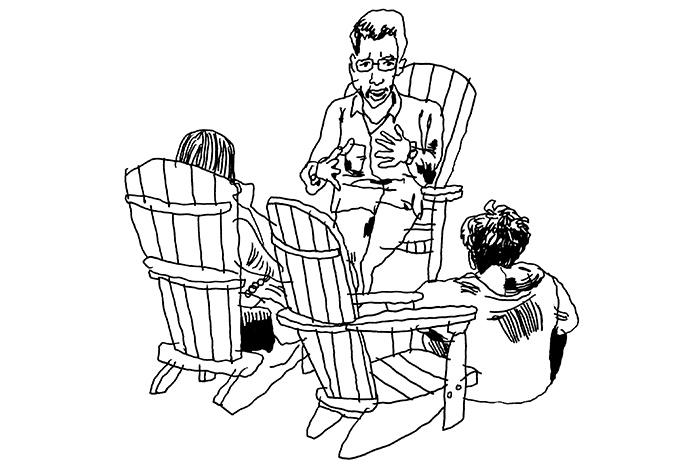
Illustration by Jason Polan.
Everyone has a story about a teacher or professor who inspired them — whether it was to take an intellectual risk, consider an alternate career trajectory or simply live life more fully. (There’s even an entire genre built around the concept: Think Dead Poets Society.)
But what we often don’t hear are the stories of students who inspired their teachers — that the best relationships are reciprocal. Consider, for example, the student-researchers in Associate Professor of Archaeology Christofilis Maggidis’ class, who turned their research upside down when they discovered that pottery that kept falling over was actually designed to hang from the ceiling. In the following vignettes, Dickinson faculty—both veteran and new—share their stories about the collaborative spirit nurtured in the classroom and beyond, leading to those moments of clarity that shine through and illuminate new paths, for them and their students alike.
Edited by Michelle Simmons and Lauren Davidson
Illustrations by Jason Polan
Ashton Nichols, professor of English and environmental studies; Walter E. Beach ’56 Distinguished Chair in Sustainability Studies
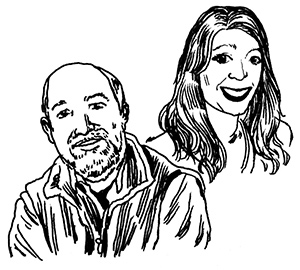
My latest student-faculty summer research student, Emily Arndt ’13, brought about a fairly significant change in my own research and writing when she worked with me on my website, Romantic Natural History. Arndt was the second student to work with me on the website; Jennifer Lindbeck ’98 had done so over a decade earlier. It was not until Arndt began her work with me in the summer of 2012 that I realized the full extent of women’s roles in the natural history of this era and their place in my research. Her work led me to appreciate that there were at least four other female literary figures—and natural historians—who deserved a place in our research: Charlotte Smith, Ann Radcliffe, Felicia Hemans and Letitia Landon. Arndt developed four additional Web pages and links, and thus opened up a whole new element of the research I continue to do.
“Learning about the roles female writers played in this literary era and having the opportunity to write about these women for an academic audience was particularly meaningful. I hadn’t known about these women prior to the research project, and they are rarely—if ever—mentioned in literature courses, even though their contributions were tremendous.” —Emily Arndt ’13
Lars English, associate professor of physics
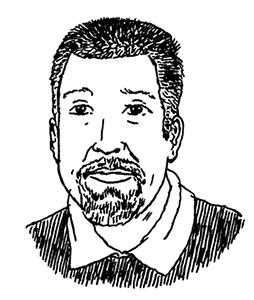 I’ve had the good fortune of working with Ritwik Niyogi ’09, a physics and neuroscience double major, and Liam Timms ’13, who ended up majoring in physics and minoring in neuroscience. Both were instrumental in helping me construct models that represented Hebbian learning in a biologically reasonable, yet mathematically tractable, way. Two co-authored papers (while they were still undergraduate students) resulted from these research experiences, both published in Physical Review E, a premier research journal for nonlinear and statistical physics. Niyogi recently earned his Ph.D. in theoretical neuroscience and machine learning from University College London and is in a postdoctoral program at the Johns Hopkins University School of Medicine, while Timms is pursuing his Ph.D. in physics at Northeastern University.
I’ve had the good fortune of working with Ritwik Niyogi ’09, a physics and neuroscience double major, and Liam Timms ’13, who ended up majoring in physics and minoring in neuroscience. Both were instrumental in helping me construct models that represented Hebbian learning in a biologically reasonable, yet mathematically tractable, way. Two co-authored papers (while they were still undergraduate students) resulted from these research experiences, both published in Physical Review E, a premier research journal for nonlinear and statistical physics. Niyogi recently earned his Ph.D. in theoretical neuroscience and machine learning from University College London and is in a postdoctoral program at the Johns Hopkins University School of Medicine, while Timms is pursuing his Ph.D. in physics at Northeastern University.
“Lars English was instrumental in me amalgamating my diverse interests. When I was merely 19, he encouraged me: ‘The future is interdisciplinary,’ sagacious words that henceforth became my motto and a successful prediction. It came to define my career, perspectives and aspirations. I also learned to think analytically, precisely and deeply through problems, both scientific and in general.” —Ritwik Niyogi ’09
Melinda Schlitt, professor of art history; William W. Edel Professor of Humanities
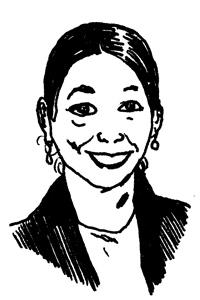 In my seminar Michelangelo: Man & Myth, a 200-level course that I’ve been teaching for years now, I’ve had students with no prerequisite and no art history take it. Michelangelo is probably the most studied and published-about artist in the history of art; the bibliography fills two or three volumes now. One of those publications—part of a series titled "Masterpieces of Western Painting by Cambridge University Press"—included an essay I had written on The Last Judgment. My work with the students, the questions and conversations that came out of the readings in the seminar led, in large part, to that essay. Those discussions about Michelangelo’s self-portrait in The Last Judgment and how the scholarship had treated it pushed me to think in different ways about it. This is an area I’ve worked in for decades and I’ve published two pretty lengthy essays on Michelangelo, but the students ask questions and often bring a different critical view to the material that I haven’t thought of. That’s why I love teaching this class—not only because the material is inexhaustible and fascinating, but also because I get a fresh group of minds every time.
In my seminar Michelangelo: Man & Myth, a 200-level course that I’ve been teaching for years now, I’ve had students with no prerequisite and no art history take it. Michelangelo is probably the most studied and published-about artist in the history of art; the bibliography fills two or three volumes now. One of those publications—part of a series titled "Masterpieces of Western Painting by Cambridge University Press"—included an essay I had written on The Last Judgment. My work with the students, the questions and conversations that came out of the readings in the seminar led, in large part, to that essay. Those discussions about Michelangelo’s self-portrait in The Last Judgment and how the scholarship had treated it pushed me to think in different ways about it. This is an area I’ve worked in for decades and I’ve published two pretty lengthy essays on Michelangelo, but the students ask questions and often bring a different critical view to the material that I haven’t thought of. That’s why I love teaching this class—not only because the material is inexhaustible and fascinating, but also because I get a fresh group of minds every time.
Jorge Sagastume, associate professor of Spanish
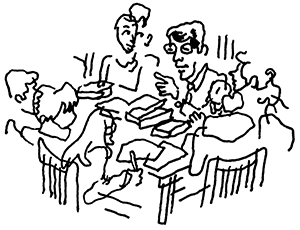 Research cannot exist without teaching: My senior seminar Reading Theatre: The Contemporary Spanish American Drama resulted in my book Responsabilidad Ätica en la lectura del texto teatral; two articles, “La traducciùn como espacio p£blico en El Quijote: Cervantes, Borges, Menard, y los otros traductores” and “ ‘El inmortal’ de Jorge Luis Borges: el yo, infinitos, absolutos y vocabularios finales,” came from a senior seminar titled Borges and Translation; two other essays “El secreto de los flamencos: Jorge Luis Borges, Federico Andahazi, y el cuestionamiento de los sistemas epistÄmicos” and “El secreto de los flamencos: Andahazi, Borges y las matemçticas” emerged from two courses: a First-Year Seminar, Borges and Mathematics, and a topics course cross-listed with Judaic studies titled Understanding the Aleph: Borges and the Hypothesis of the Continuum. The latter also motivated student Ruth Dicker ’10 to write an honors thesis on Borges, which in turn allowed her to gain acceptance into the master’s program at Universidad Nacional Autùnoma de MÄxico. In each course I teach I come to the classroom with a specific idea in mind; however, by the end of the semester these ideas are reshaped and end up as publications that would be significantly different if my students were not to respond critically to my thoughts.
Research cannot exist without teaching: My senior seminar Reading Theatre: The Contemporary Spanish American Drama resulted in my book Responsabilidad Ätica en la lectura del texto teatral; two articles, “La traducciùn como espacio p£blico en El Quijote: Cervantes, Borges, Menard, y los otros traductores” and “ ‘El inmortal’ de Jorge Luis Borges: el yo, infinitos, absolutos y vocabularios finales,” came from a senior seminar titled Borges and Translation; two other essays “El secreto de los flamencos: Jorge Luis Borges, Federico Andahazi, y el cuestionamiento de los sistemas epistÄmicos” and “El secreto de los flamencos: Andahazi, Borges y las matemçticas” emerged from two courses: a First-Year Seminar, Borges and Mathematics, and a topics course cross-listed with Judaic studies titled Understanding the Aleph: Borges and the Hypothesis of the Continuum. The latter also motivated student Ruth Dicker ’10 to write an honors thesis on Borges, which in turn allowed her to gain acceptance into the master’s program at Universidad Nacional Autùnoma de MÄxico. In each course I teach I come to the classroom with a specific idea in mind; however, by the end of the semester these ideas are reshaped and end up as publications that would be significantly different if my students were not to respond critically to my thoughts.
Neil Leary, director of the Center for Sustainability Education
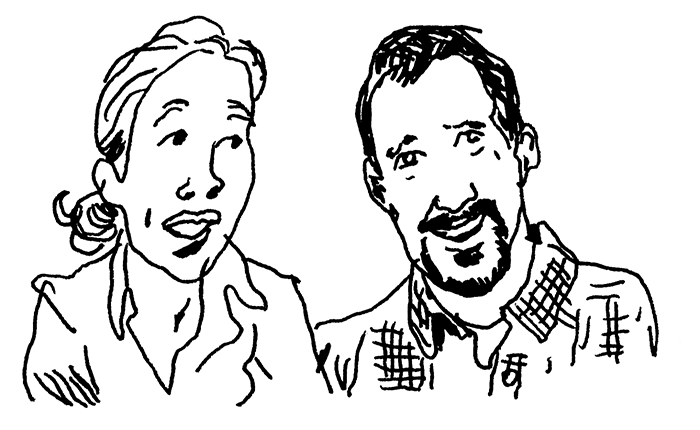 In 2013-14 I supervised Elizabeth de la Reguera ’14’s senior research. She was calculating Dickinson’s nitrogen footprint, an outgrowth of her semester at the Marine Biology Lab (MBL) with James Galloway of the University of Virginia (U.Va.). Galloway had co-developed a methodology and spreadsheet tool for calculating institutions’ nitrogen footprints, and de la Reguera initiated the project for Dickinson when she returned from the MBL. Following de la Reguera’s honors thesis defense in environmental studies, Galloway invited Dickinson to join U.Va. in a multi-institutional project on nitrogen footprints. We’re in the first year of a three-year collaboration with U.Va., as well as participating institutions Brown, Colorado State and Eastern Mennonite universities, the University of New Hampshore and the MBL. De la Reguera now works for MBL as a research assistant.
In 2013-14 I supervised Elizabeth de la Reguera ’14’s senior research. She was calculating Dickinson’s nitrogen footprint, an outgrowth of her semester at the Marine Biology Lab (MBL) with James Galloway of the University of Virginia (U.Va.). Galloway had co-developed a methodology and spreadsheet tool for calculating institutions’ nitrogen footprints, and de la Reguera initiated the project for Dickinson when she returned from the MBL. Following de la Reguera’s honors thesis defense in environmental studies, Galloway invited Dickinson to join U.Va. in a multi-institutional project on nitrogen footprints. We’re in the first year of a three-year collaboration with U.Va., as well as participating institutions Brown, Colorado State and Eastern Mennonite universities, the University of New Hampshore and the MBL. De la Reguera now works for MBL as a research assistant.
“To be able to say I was a senior in college, with advising from three mentors, and to be able to produce an entire footprint for the college, working by myself, is amazing.” —Elizabeth de la Reguera ’14
Marcus Key, Joseph Priestley Professor of Natural Philosophy
 Steven Lev ’92 was working with me on a project trying to quantify the rate of growth in trepostome bryozoans, fossil marine colonial animals that grow like coral. We used a technique applied to trees of counting and measuring tree ring widths. Lev was working in my lab, on my research project, like a lot of my other students have, when he came up with his own idea to test a related but different hypothesis. He applied a concept he had learned in one of my classes to correlate growth rates: For example, do all the trees in the Cumberland Valley show the same response to a severe drought? His theory was that we could ask the same question of fossil bryozoan colonies that co-existed in one place. The result of his research was his first publication, which we co-authored, in Journal of the Pennsylvania Academy of Science. Lev went on to earn his master’s at the University of Cincinnati and his Ph.D. at SUNY-Stony Brook. He is on the research staff at the Science and Technology Policy Institute.
Steven Lev ’92 was working with me on a project trying to quantify the rate of growth in trepostome bryozoans, fossil marine colonial animals that grow like coral. We used a technique applied to trees of counting and measuring tree ring widths. Lev was working in my lab, on my research project, like a lot of my other students have, when he came up with his own idea to test a related but different hypothesis. He applied a concept he had learned in one of my classes to correlate growth rates: For example, do all the trees in the Cumberland Valley show the same response to a severe drought? His theory was that we could ask the same question of fossil bryozoan colonies that co-existed in one place. The result of his research was his first publication, which we co-authored, in Journal of the Pennsylvania Academy of Science. Lev went on to earn his master’s at the University of Cincinnati and his Ph.D. at SUNY-Stony Brook. He is on the research staff at the Science and Technology Policy Institute.
Amy Wlodarski, associate professor of music
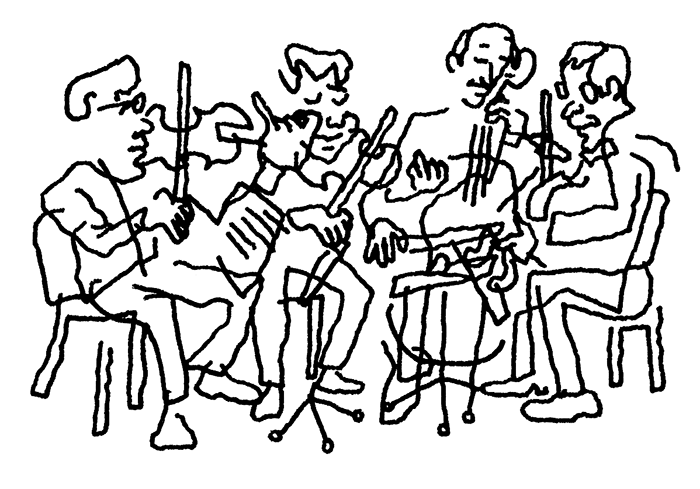 I was teaching Different Trains, the Holocaust-inspired work for string quartet and tape by composer Steve Reich, in my introductory music class. The piece features sampled voices of Holocaust survivors, and after class one day, a group of students asked if they could learn more about the survivors. As I researched and dug deeper into the survivors’ stories, I discovered that Reich had misheard two key portions of their testimonies that ultimately changed both their stories and the tone of the musical work. I eventually authored an article for the Journal for the American Musicological Society that details the lives of the survivors and explores the ethical and aesthetic consequences of Reich’s mistakes. The article garnered a national scholarship award and prompted Carnegie Hall to reconsider which libretto they should use for a performance of Different Trains. I never would have delved into the survivor testimonies if my students hadn’t asked the question, one that I (and other musicologists) had never considered. Their question reminded me of the human lives at the center of the work and the dangers of aesthetic representations of the Holocaust, especially those that appropriate the voices of others in the name of art. I am grateful to have taught them—and in my very first year as a professor at Dickinson.
I was teaching Different Trains, the Holocaust-inspired work for string quartet and tape by composer Steve Reich, in my introductory music class. The piece features sampled voices of Holocaust survivors, and after class one day, a group of students asked if they could learn more about the survivors. As I researched and dug deeper into the survivors’ stories, I discovered that Reich had misheard two key portions of their testimonies that ultimately changed both their stories and the tone of the musical work. I eventually authored an article for the Journal for the American Musicological Society that details the lives of the survivors and explores the ethical and aesthetic consequences of Reich’s mistakes. The article garnered a national scholarship award and prompted Carnegie Hall to reconsider which libretto they should use for a performance of Different Trains. I never would have delved into the survivor testimonies if my students hadn’t asked the question, one that I (and other musicologists) had never considered. Their question reminded me of the human lives at the center of the work and the dangers of aesthetic representations of the Holocaust, especially those that appropriate the voices of others in the name of art. I am grateful to have taught them—and in my very first year as a professor at Dickinson.
Carol Ann Johnston, professor of English; Martha Porter Sellers Chair of Rhetoric and the English Language
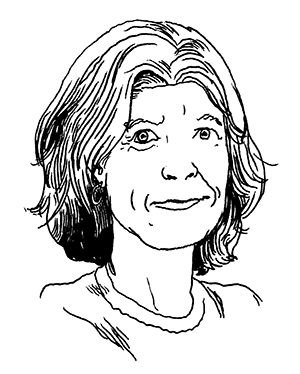 Early in my career here I was writing a book on the Mississippi writer Eudora Welty. My Dana intern, Emily Wylie ’94, helped me on the project in immeasurable ways. I talked through ideas on Welty’s short stories with Wylie for the better part of two years. In addition to being my intern, she wrote her honors thesis in English on Welty. The specific difference she made in the work, however, is that she very earnestly wanted to go to Jackson to visit Ms. Welty. I was far more shy about doing this but was reluctant to “let down” Emily. So we did, in fact, go to Jackson, Miss., and we did spend an amazing afternoon with Welty. Without Wylie’s desire and perseverance, that would not have happened. The trip was her first time in the Deep South, and seeing the culture through her eyes opened my eyes to several things: the nature of my own experience as a southerner at Harvard University, how Welty must have felt going to Harvard to give a series of lectures (which I had the amazing pleasure of hearing), and how different Southern culture really is from that of the Northeast. My 2003 essay, “‘The treasure most dearly regarded by me’: Eudora Welty’s Massey Lectures in the History of American Civilization,” couldn’t have been written without having gone to Jackson with Wylie.
Early in my career here I was writing a book on the Mississippi writer Eudora Welty. My Dana intern, Emily Wylie ’94, helped me on the project in immeasurable ways. I talked through ideas on Welty’s short stories with Wylie for the better part of two years. In addition to being my intern, she wrote her honors thesis in English on Welty. The specific difference she made in the work, however, is that she very earnestly wanted to go to Jackson to visit Ms. Welty. I was far more shy about doing this but was reluctant to “let down” Emily. So we did, in fact, go to Jackson, Miss., and we did spend an amazing afternoon with Welty. Without Wylie’s desire and perseverance, that would not have happened. The trip was her first time in the Deep South, and seeing the culture through her eyes opened my eyes to several things: the nature of my own experience as a southerner at Harvard University, how Welty must have felt going to Harvard to give a series of lectures (which I had the amazing pleasure of hearing), and how different Southern culture really is from that of the Northeast. My 2003 essay, “‘The treasure most dearly regarded by me’: Eudora Welty’s Massey Lectures in the History of American Civilization,” couldn’t have been written without having gone to Jackson with Wylie.
“Working with Johnston on her Welty project was the defining experience of my academic life. The work uncovered and exercised abilities I didn’t know I had, filled in and reformed deficits, grew me up all over.” —Emily Wylie ’94
Amy Farrell, professor of American studies and women’s & gender studies; John J. Curley ’60 and Ann Conser Curley ’63 Faculty Chair in the Liberal Arts
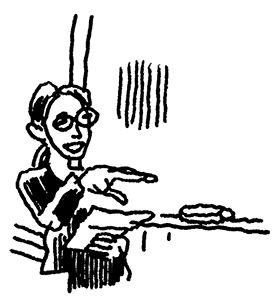 As I was finishing my first book, Yours in Sisterhood: Ms. Magazine and the Politics of Popular Feminism, I was casting about for a new research project. I regularly taught Joan Brumberg’s history of anorexia, Fasting Girls, in my Introduction to Women’s Studies course. My students loved it, and we talked deeply and in complex ways about eating disorders, dieting and the imperative to be thin. Those discussions, as well as Brumberg’s statement that there wasn’t a thorough history of dieting in the U.S.,made me start thinking about dieting for a second project. The project changed shape—it turns out there was a good history of dieting — and I also decided that I was more interested in the history of fat than in the history of thin. Throughout all the permutations of my research until the final product, Fat Shame: Stigma and the Fat Body in American Culture, it was student inquiry and enthusiasm that kept me focused on what turned out to be a 10-year research project.
As I was finishing my first book, Yours in Sisterhood: Ms. Magazine and the Politics of Popular Feminism, I was casting about for a new research project. I regularly taught Joan Brumberg’s history of anorexia, Fasting Girls, in my Introduction to Women’s Studies course. My students loved it, and we talked deeply and in complex ways about eating disorders, dieting and the imperative to be thin. Those discussions, as well as Brumberg’s statement that there wasn’t a thorough history of dieting in the U.S.,made me start thinking about dieting for a second project. The project changed shape—it turns out there was a good history of dieting — and I also decided that I was more interested in the history of fat than in the history of thin. Throughout all the permutations of my research until the final product, Fat Shame: Stigma and the Fat Body in American Culture, it was student inquiry and enthusiasm that kept me focused on what turned out to be a 10-year research project.
Nicola Tynan, associate professor of economics
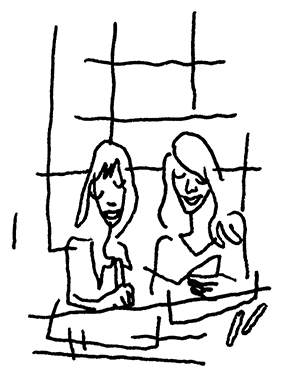 When GIS Specialist Jim Ciarrocca put me in touch with archaeology and anthropology double-major Tessa Cicak ’13, I was just looking for a student to help me create maps to better illustrate my economic history research. Every time I presented to an audience, usually economists who aren’t familiar with London, they struggled to envision overlapping water-supply networks. They would say, “If only we had a map!” At the time, I did not have coordinate information, just names of sub-districts. You can look at numbers in a spreadsheet, but it’s very hard to get a sense of what that really means just looking at the data. The map allows you to see that connection between the data and the geographic location. As Cicak worked, we developed a larger mapping project, which traces John Snow’s epidemiological study of the 1854 cholera epidemic in London. The London Metropolitan Archives liked one map so much that they asked if they could give it out to researchers coming to the library, and our resulting article, “Mapping London’s Water Companies and Cholera Deaths,” which was accepted without revisions (a rare occurrence) by The London Journal, was published in March. Cicak is now pursuing a Ph.D. in anthropology at the University of Minnesota.
When GIS Specialist Jim Ciarrocca put me in touch with archaeology and anthropology double-major Tessa Cicak ’13, I was just looking for a student to help me create maps to better illustrate my economic history research. Every time I presented to an audience, usually economists who aren’t familiar with London, they struggled to envision overlapping water-supply networks. They would say, “If only we had a map!” At the time, I did not have coordinate information, just names of sub-districts. You can look at numbers in a spreadsheet, but it’s very hard to get a sense of what that really means just looking at the data. The map allows you to see that connection between the data and the geographic location. As Cicak worked, we developed a larger mapping project, which traces John Snow’s epidemiological study of the 1854 cholera epidemic in London. The London Metropolitan Archives liked one map so much that they asked if they could give it out to researchers coming to the library, and our resulting article, “Mapping London’s Water Companies and Cholera Deaths,” which was accepted without revisions (a rare occurrence) by The London Journal, was published in March. Cicak is now pursuing a Ph.D. in anthropology at the University of Minnesota.
Illustrations by Jason Polan.
Read more of the alumni perspectives on these inspirational experiences in a Web exclusive.
Read more from the spring 2015 issue of Dickinson Magazine.
Learn more
Published April 14, 2015